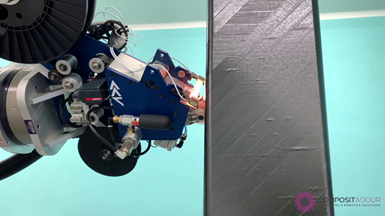AFP-XS platform demonstrates rectangular tube manufacture
Addcomposites collaborated with MBDA and Compositadour to produce lightweight, stiff and weatherproof components that are electrically insulating, chemically resistant and dimensionally stable.
In collaboration with defense manufacturer MBDA Systems (Le Plessis-Robinson, France) and the Compositadour (Bayonne, France) team, Addcomposites (Espoo, Finland) recently demonstrated the process for manufacturing rectangular tubes with its AFP-XS platform. The layup program was generated using the winding feature of the company’s AddPath software. As shown in the video above, layup on the sharp radial corners ensured wrinkle/pucker-free layup through sharp steering.

Photo Credit: Addcomposites, Compositadour
What was the reasoning behind manufacturing rectangular tubes? According to Addcomposites, this shape offers several benefits, including aesthetic appeal and high strength-to-weight ratios (compared to other forms of beams). Rectangular tubes are said to also exhibit high load-bearing properties — in both torsional and compression directions — enabling them to be suited to many different applications, as well as optimized environmental resistance, ideal for outdoor applications. Tubes are commonly used as structural elements in buildings, bridges and a wide variety of end-use consumer applications. Additional applications include tool handles, constrained telescopic structures, booms, lightweight housings, sports equipment, robot arms and antenna tubes.
The importance of using the automated fiber placement (AFP) process, says Addcomposites, further reduces wall thickness and weight, while improving stiffness and strength. This is in comparison to conventional winding and pultrusion. Moreover, each part can be optimized according to application requirements, via fiber orientation, localized reinforcements and diameters ranging from 20-1,000 millimeters. The resulting rectangular tube is a lightweight, stiff and weatherproof structure that is electrically insulating, chemically resistant and dimensionally stable.
Related Content
-
Heat mapping simulation to improve AFP parts
An optical model developed for Coriolis Composites’ SimuReal AFP process simulation software enables verification of energy distributions during AFP to better define heating laws.
-
Plant tour: BeSpline/Addcomp, Sherbrooke, QC, Canada
Composites automation specialist increases access to next-gen technologies, including novel AFP systems and unique 3D parts using adaptive molds.
-
The next evolution in AFP
Automated fiber placement develops into more compact, flexible, modular and digitized systems with multi-material and process capabilities.













